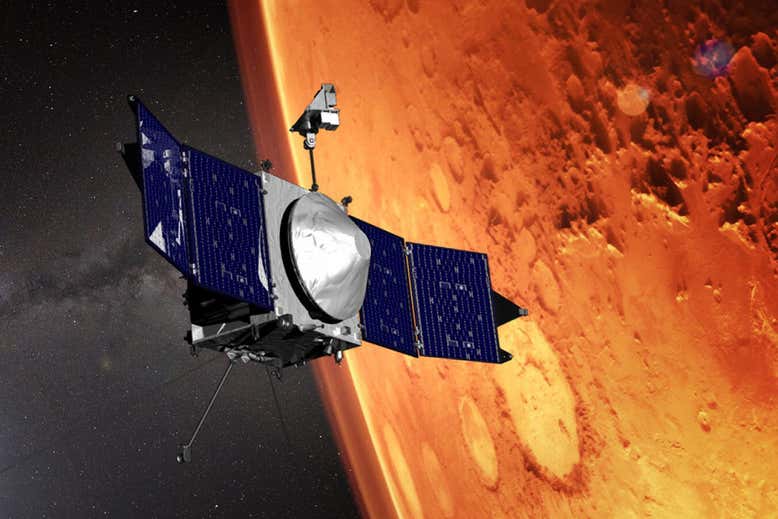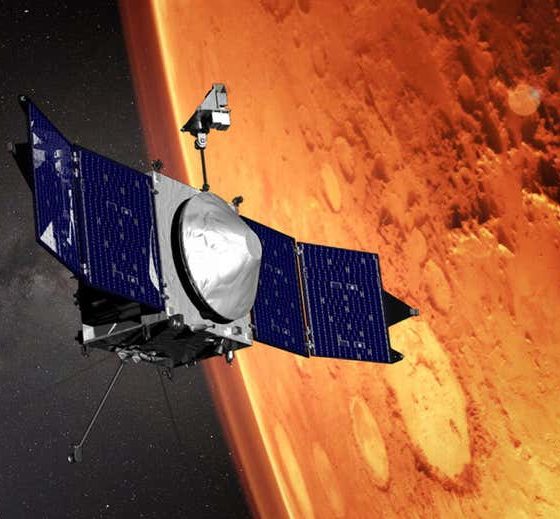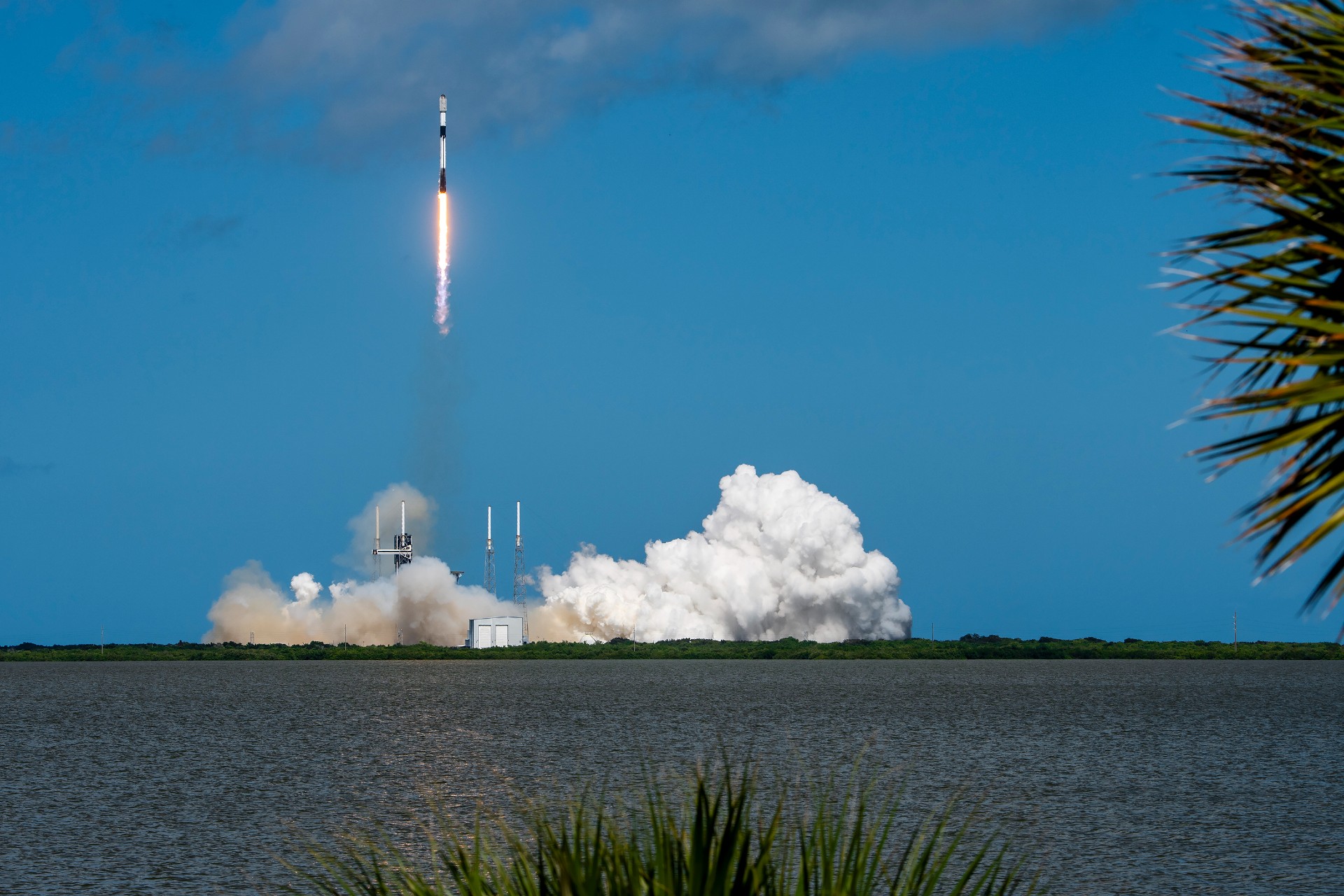

Space
Mars’ atmosphere could help us better understand radio interference here on Earth
Have you ever tuned in to your favorite radio station only to hear another station playing on top of it? That’s a result of a weird atmospheric phenomenon called a sporadic E layer.
The Earth’s upper atmosphere, called the ionosphere, is a region full of charged particles. Those particles can be blown about by the wind, forming clumps called sporadic E layers. These dense layers of ions are constantly in flux — appearing and disappearing at random — which can be disruptive to radio communications.
With the help of the Mars Atmosphere and Volatile Evolution (MAVEN) spacecraft, NASA scientists have discovered the same phenomenon at Mars, which will help scientists better understand them. Even though these layers are quite common here on Earth, they form at altitudes that are very difficult to explore.
Mars has a thinner atmosphere that allows spacecraft, like MAVEN, to fly at lower altitudes and observe many of these weird layers.
“The low altitudes observable by MAVEN will fill in a great gap in our understanding of this region on both Mars and Earth, with really significant discoveries to be had,” Joe Grebowsky, a former MAVEN project scientist at Goddard, said in a statement.
MAVEN uncovered two types of structures — called layers and rifts — while studying the Martian ionosphere. The layers typically form suddenly and last for hours, acting like a mirror and reflecting radio signals. Scientists have known about the existence of these layers for a decade but have never been able to study them in detail until now.
“The layers are so close above all our heads at Earth and can be detected by anyone with a radio, but they are still quite mysterious,” Glyn Collinson of NASA’s Goddard Space Flight Center in Greenbelt, Maryland, and lead author on the study explained in the same statement. “Who would have thought one of the best ways to understand them is to launch a satellite 300 million miles to Mars?”
In total, the team found 34 E layers in the MAVEN data. They form higher in the Martian atmosphere and are probably too high to interfere with any future radio communications on the ground, which is good news for future human missions.
But they are troublesome here on Earth. In addition to interfering with your radio listening enjoyment, they can also block crucial radar signals that track things like aircraft and missiles.

In addition to the layers, MAVEN also found “rifts” in the planet’s atmosphere. These are gaps in the plasma — basically the opposite of a layer. These areas have never been spotted on Earth.
One thing the team noticed in the data is that the layers and rifts seem to always form at the same places. They think that’s because of how the charged particles in Mars’s ionosphere react to its tangled magnetic field.
This observation could make them much easier to find and predict at Mars, which could help scientists identify them easier here on Earth and mitigate their effects.
The research was published in a paper in the journal Nature Astronomy.

Cybertruck
Tesla Cybertruck fleet takes over at SpaceX’s Starbase
Interestingly, the Cybertruck uses the same exterior, a stainless steel alloy, as SpaceX rockets. This synergy between the two companies and their very different products shows a very unified mentality between Musk companies.

Tesla Cybertrucks have taken over at SpaceX’s Starbase facility in Texas, as hundreds of the all-electric pickup trucks were spotted late last week rounding out a massive fleet of vehicles.
The Cybertruck fleet is geared toward replacing gas vehicles that are used at Starbase for everyday operations. The only surprise about this is that it was not done sooner:
Was just visiting. pic.twitter.com/5Q9wPPaeuH
— Derek Li (@derek1ee) October 31, 2025
Deliveries have been going on for a few weeks, as Cybertrucks have made their way across the state of Texas from Austin to Starbase so they could be included in SpaceX’s fleet of vehicles at the facility.
Interestingly, the Cybertruck uses the same exterior, a stainless steel alloy, as SpaceX rockets. This synergy between the two companies and their very different products shows a very unified mentality between Musk companies.
However, there are some other perspectives to consider as SpaceX is utilizing such a massive fleet of Cybertrucks. Some media outlets (unsurprisingly) are seeing this as a move of weakness by both Tesla and SpaceX, as the aerospace company is, in a sense, “bailing out” lagging sales for the all-electric pickup.
It’s no secret that Tesla has struggled with the Cybertruck this year, and deliveries have been underwhelming in the sense that the company was anticipating between 1 million and 2 million orders for the vehicle before it was widely produced.
A lot of things changed with the Cybertruck between its 2019 unveiling and 2023 initial deliveries, most notably, price.
The price of the Cybertruck swelled significantly and priced out many of those who had pre-ordered it. Some have weighed the option of whether this purchase was a way to get rid of sitting inventory.
However, it seems more logical to consider the fact that SpaceX was likely always going to transition to Teslas for its fleet, especially at Starship, at some point.
It doesn’t seem out of the question that one Musk company would utilize another Musk company’s products, especially considering the Cybertruck has been teased as the vehicle that would be present on Mars.
News
SpaceX opens up free Starlink service for those impacted by Hurricane Melissa

SpaceX is opening up its internet service, Starlink, to those impacted by Hurricane Melissa, as it made landfall in Jamaica and the Bahamas as a Category 5 storm.
Hurricane Melissa is expected to reach wind speeds of over 165 MPH over the next few days as it extends out into the Atlantic Ocean by Thursday and Friday.
Satellite imagery shows Hurricane #Melissa‘s growth from its formation on October 21 to a Category 5 hurricane through October 27, 2025. #HurricaneMelissa pic.twitter.com/goR3Hbgb9c
— The Weather Network (@weathernetwork) October 27, 2025
Citizens in Jamaica and the Bahamas have been preparing for the storm for the past week, getting necessary goods together and preparing for the massive storm to arrive. It finally did yesterday, and the first images and video of the storm are showing that it could destroy many parts of both countries.
Starlink is now being opened up for free until the end of November for those impacted by the storm in Jamaica and the Bahamas, SpaceX announced today:
For those impacted by Hurricane Melissa in Jamaica and the Bahamas, Starlink service is now free through the end of November to help with response and recovery efforts → https://t.co/fUko3xSviJ
— Starlink (@Starlink) October 28, 2025
It is a move similar to the one the company made last year as Hurricane Helene made its way through the United States, destroying homes and property across the East Coast. SpaceX offered free service for those impacted by the destruction caused by the storm.
The free Starlink service was available until the end of 2024.
Elon Musk’s companies have also made similar moves to help out those who are impacted by natural disasters. Tesla has offered Free Supercharging in the past, most notably during the California wildfires.
Tesla and SpaceX’s LA fire relief efforts: Cybertrucks, free Starlink and more
One major advantage of Starlink is that it is available for use in situations like this one, where power might be required to operate things like a modem and router.
Internet access is a crucial part of survival in these situations, especially as it can be the last leg some stand on to get in touch with emergency services or loved ones.
News
SpaceX reaches incredible Starlink milestone

SpaceX has reached an incredible milestone with its Starlink program, officially surpassing 10,000 satellites launched into low Earth orbit since starting the program back in 2019.
Last Sunday, October 19, SpaceX launched its 131st and 132nd Falcon 9 missions of 2025, one from Cape Canaveral, Florida, and the other from Vandenberg, California.
The 10,000th Starlink satellite was aboard the launch from California, which was Starlink 11-19, and held 28 v2 mini optimized satellites.
The achievement was marked by a satellite tracker developed by Jonathan McDowell.
🚨 With its Falcon 9 launch last Sunday, SpaceX officially has 10,000 Starlink satellites in orbit pic.twitter.com/xS5RVZ4ix0
— TESLARATI (@Teslarati) October 26, 2025
The first Starlink launch was all the way back on May 23, 2019, as SpaceX launched its first 60 satellites from Cape Canaveral using a Falcon 9 rocket.
Of the over 10,000 satellites in orbit, the tracker says 8,608 are operational, as some are intentionally de-orbited after becoming faulty and destroyed in the atmosphere.
SpaceX has truly done some really incredible things during its development of the Starlink program, including launch coverage in a global setting, bringing along millions of active subscribers that use the service for personal and business use, locking up commercial partnerships, and more.
Starlink currently operates in around 150 countries, territories, and markets and is available at least somewhere on all seven continents.
Additionally, Starlink has over 5 million subscribers worldwide, and 2.7 million have joined the program over the past year. It has revolutionized internet access on commercial aircraft as well, as several high-profile airlines like Qatar and United, among many others, have already installed Starlink on some of their planes to deliver more stable connectivity for passengers and crew.
SpaceX has the approval to launch 12,000 Starlink satellites from the FAA, but it plans to bring over 30,000 to its constellation, giving anyone the ability to have access to high-speed internet.









